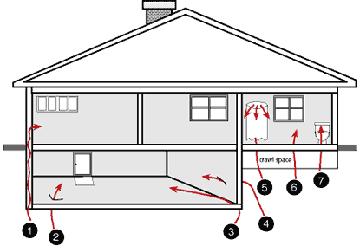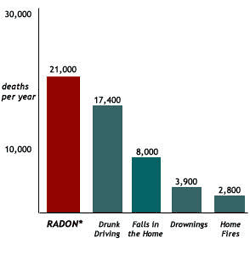Radon TEsting
Potential Radon Entry Points In Your Home:

- Cavities inside walls
- Cracks in solid floors
- Construction joints
- Cracks in walls
- The water supply
- Gaps in suspended floors
- Gaps around service pipes
What you should know about Radon

The EPA strongly recommends testing every two years.
Radon
is a cancer causing radioactive gas. You cannot see radon and you cannot
smell it or taste it, but may be a problem in your home. This is because
when you breathe air-containing radon, you increase your risk of getting
lung cancer. In fact, the Surgeon General has warned that radon is the
second leading cause of lung cancer. You should test for Radon. Testing
is the only way to find out about your home's radon level. The EPA and
the Surgeon General recommend testing testing of all homes below the
third floor for radon. You can fix a radon problem. If you find that you
have high radon levels, there are ways to fix a radon problem. Even very
high levels can be reduced to acceptable levels. If you are buying a
home. EPA recommends that you ob tain the radon level in the home you are
considering buying. An EPA publication "The Home Buyer's and Seller's
Guide" is available through most Sate Health Departments or Regional EPA
offices listed in your local phone book. EPA also recommends that you
use a certified or state licensed radon tester to perform the test. If
elevated levels are found, it is
recommended that these levels be reduced. In most cases, a
professional can accomplish this at reasonable cost or homeowner
installed mitigation system that adheres to the EPA'S approved methods
for reduction of radon in a residential structure. For
more information on Radon Gases , please see the
EPA's Website.
tain the radon level in the home you are
considering buying. An EPA publication "The Home Buyer's and Seller's
Guide" is available through most Sate Health Departments or Regional EPA
offices listed in your local phone book. EPA also recommends that you
use a certified or state licensed radon tester to perform the test. If
elevated levels are found, it is
recommended that these levels be reduced. In most cases, a
professional can accomplish this at reasonable cost or homeowner
installed mitigation system that adheres to the EPA'S approved methods
for reduction of radon in a residential structure. For
more information on Radon Gases , please see the
EPA's Website.
